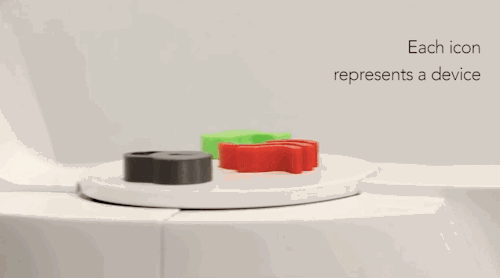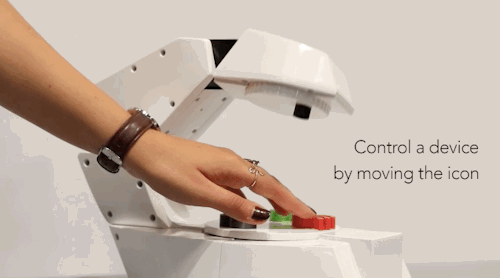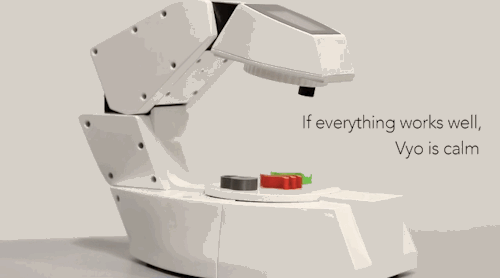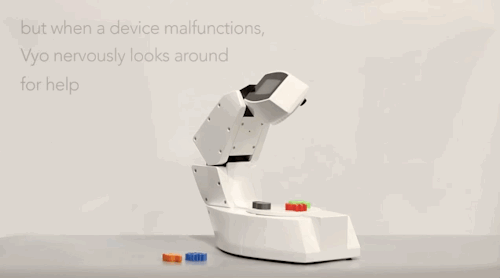One Of The Huffington Post's Article On The GOP Convention Included This At The End.

One of the Huffington Post's article on the GOP convention included this at the end.
More Posts from Stubborn-turtle-blog and Others
This would have been so empowering for my ALS-stricken grandfather

Obi was built by Jon and Tom Dekar, the father-son duo that founded Obi parent company DESῙN in 2010. They spent the next six years refining Obi’s design, securing investors, sourcing suppliers, and testing prototypes. The first Obi prototype was designed in 2006 by Jon, a University of Dayton engineering student, who saw the challenges faced by people with disabilities as varied as his aging grandfather and a 6-year-old girl with Arthrogryposis.
“Every day, millions of people must be fed by caregivers, and they find the experience to be conspicuous and frustrating,” Jon said. “Feeding oneself is a basic human need, and there was no good solution available. I became inspired to change that.”
Constellations and the Calendar
Did you recently hear that NASA changed the zodiac signs? Nope, we definitely didn’t…
…Here at NASA, we study astronomy, not astrology. We didn’t change any zodiac signs, we just did the math. Here are the details:
First Things First: Astrology is NOT Astronomy…
Astronomy is the scientific study of everything in outer space. Astronomers and other scientists know that stars many light years away have no effect on the ordinary activities of humans on Earth.
Astrology is something else. It’s not science. No one has shown that astrology can be used to predict the future or describe what people are like based on their birth dates.

Some curious symbols ring the outside of the Star Finder. These symbols stand for some of the constellations in the zodiac. What is the zodiac and what is special about these constellations?

Imagine a straight line drawn from Earth though the sun and out into space way beyond our solar system where the stars are. Then, picture Earth following its orbit around the sun. This imaginary line would rotate, pointing to different stars throughout one complete trip around the sun – or, one year. All the stars that lie close to the imaginary flat disk swept out by this imaginary line are said to be in the zodiac.

The constellations in the zodiac are simply the constellations that this imaginary straight line points to in its year-long journey.
What are Constellations?
A constellation is group of stars like a dot-to-dot puzzle. If you join the dots—stars, that is—and use lots of imagination, the picture would look like an object, animal, or person. For example, Orion is a group of stars that the Greeks thought looked like a giant hunter with a sword attached to his belt. Other than making a pattern in Earth’s sky, these stars may not be related at all.

Even the closest star is almost unimaginably far away. Because they are so far away, the shapes and positions of the constellations in Earth’s sky change very, very slowly. During one human lifetime, they change hardly at all.
A Long History of Looking to the Stars
The Babylonians lived over 3,000 years ago. They divided the zodiac into 12 equal parts – like cutting a pizza into 12 equal slices. They picked 12 constellations in the zodiac, one for each of the 12 “slices.” So, as Earth orbits the sun, the sun would appear to pass through each of the 12 parts of the zodiac. Since the Babylonians already had a 12-month calendar (based on the phases of the moon), each month got a slice of the zodiac all to itself.

But even according to the Babylonians’ own ancient stories, there were 13 constellations in the zodiac. So they picked one, Ophiuchus, to leave out. Even then, some of the chosen 12 didn’t fit neatly into their assigned slice of the pie and crossed over into the next one.

When the Babylonians first invented the 12 signs of zodiac, a birthday between about July 23 and August 22 meant being born under the constellation Leo. Now, 3,000 years later, the sky has shifted because Earth’s axis (North Pole) doesn’t point in quite the same direction.

The constellations are different sizes and shapes, so the sun spends different lengths of time lined up with each one. The line from Earth through the sun points to Virgo for 45 days, but it points to Scorpius for only 7 days. To make a tidy match with their 12-month calendar, the Babylonians ignored the fact that the sun actually moves through 13 constellations, not 12. Then they assigned each of those 12 constellations equal amounts of time.
So, we didn’t change any zodiac signs…we just did the math.
Make sure to follow us on Tumblr for your regular dose of space: http://nasa.tumblr.com
The wood siding could age badly unless it's well-treated, but otherwise cool.
It’s Friday...Come Space Out with Us
It’s Friday…which seems like a great excuse to take a look at some awesome images from space.
First, let’s start with our home planet: Earth.

This view of the entire sunlit side of Earth was taken from one million miles away…yes, one MILLION! Our EPIC camera on the Deep Space Climate Observatory captured this image in July 2015 and the picture was generated by combining three separate images to create a photographic-quality image.
Next, let’s venture out 4,000 light-years from Earth.

This image, taken by the Hubble Space Telescope, is not only stunning…but shows the colorful “last hurrah” of a star like our sun. This star is ending its life by casting off its outer layers of gas, which formed a cocoon around the star’s remaining core. Our sun will eventually burn out and shroud itself with stellar debris…but not for another 5 billion years.
The material expelled by the star glows with different colors depending on its composition, its density and how close it is to the hot central star. Blue samples helium; blue-green oxygen, and red nitrogen and hydrogen.
Want to see some rocks on Mars?

Here’s an image of the layered geologic past of Mars revealed in stunning detail. This color image was returned by our Curiosity Mars rover, which is currently “roving” around the Red Planet, exploring the “Murray Buttes” region.
In this region, Curiosity is investigating how and when the habitable ancient conditions known from the mission’s earlier findings evolved into conditions drier and less favorable for life.
Did you know there are people currently living and working in space?

Right now, three people from three different countries are living and working 250 miles above Earth on the International Space Station. While there, they are performing important experiments that will help us back here on Earth, and with future exploration to deep space.
This image, taken by NASA astronaut Kate Rubins shows the stunning moonrise over Earth from the perspective of the space station.
Lastly, let’s venture over to someplace REALLY hot…our sun.

The sun is the center of our solar system, and makes up 99.8% of the mass of the entire solar system…so it’s pretty huge. Since the sun is a star, it does not have a solid surface, but is a ball of gas held together by its own gravity. The temperature at the sun’s core is about 27 million degrees Fahrenheit (15 million degrees Celsius)…so HOT!
This awesome visualization appears to show the sun spinning, as if stuck on a pinwheel. It is actually the spacecraft, SDO, that did the spinning though. Engineers instructed our Solar Dynamics Observatory (SDO) to roll 360 degrees on one axis, during this seven-hour maneuver, the spacecraft took an image every 12 seconds.
This maneuver happens twice a year to help SDO’s imager instrument to take precise measurements of the solar limb (the outer edge of the sun as seen by SDO).
Thanks for spacing out with us…you may now resume your Friday.
Make sure to follow us on Tumblr for your regular dose of space: http://nasa.tumblr.com

When astronomy honour’s student Michelle Kunimoto graduates on Monday, she’ll do so already holding the honour of being a galactic pioneer with distinction.
The 22-year-old University of British Columbia undergraduate has discovered four new planets in the Cygnus (Swan) constellation, known as “exoplanets” because they’re outside our solar system.
“I got interested in exoplanets from Star Trek,” she told Metro in an interview in UBC’s physics department. “The whole theme of Star Trek, curiosity and exploration, is really important for the long, long, long term. We want to answer the age-old question: Are we alone?”
She spent months poring through 400 different data samples from the Kepler space telescope, which captures the curves of light from distant stars. Sudden dips in their light can correspond to planets passing in front of them.
Kunimoto likened her method to trying to hear one quiet voice in a crowded room full of loud talkers. But when she first noticed the faint but tell-tale dip, she didn’t allow herself get excited.
“I had to be very careful,” she explained. “I ran them through a lot of tests, but the more tests I ran, the more confident I felt.
“When they all passed the right tests, and I had these four planets remaining, that was really exciting!”
The planet she’s most enthusiastic about is called Kepler Object Of Interest 408.05, which she nicknamed “Warm Neptune,” because it’s roughly the size of its namesake planet, but is within the distance needed for the warm, Earth-like atmosphere needed to host life. It’s 3,200 light years from Earth.
Technically, what she found are still considered “planet candidates” until they can be independently confirmed, but for her UBC supervisor the results are clear.
“It’s rare that you have that ‘Eureka!’ moment any more,” astronomy professor Jaymie Matthews told Metro proudly. “Michelle’s discovery was time-consuming, and she’s done this for only 400 out of 150,000 light curves.”
But will Kunimoto’s “Warm Neptune” — located within what Matthews dubbed the “Goldilocks” zone of planets that are neither too hot nor too cold to support life — potentially be home to intelligent life?
“You can bet that once the results are confirmed and more widely disseminated, the Search for Extraterrestrial Intelligence Institute will put KOI-408.05 on their list of higher-priority targets to monitor,” Matthews said. “If there is life and signals we could eavesdrop on, these are the places they’d be coming from.”
On Saturday, Kunimoto got a shout-out before a large UBC audience from Star Trek star William Shatner, who praised her discoveries on stage. “I was really honoured!” she said. “That was completely unexpected, my face was going red.”
Getting to Mars: What It’ll Take
Join us as we take a closer look at the next steps in our journey to the Red Planet:
The journey to Mars crosses three thresholds, each with increasing challenges as humans move farther from Earth. We’re managing these challenges by developing and demonstrating capabilities in incremental steps:
Earth Reliant

Earth Reliant exploration is focused on research aboard the International Space Station. From this world-class microgravity laboratory, we are testing technologies and advancing human health and performance research that will enable deep space, long duration missions.
On the space station, we are advancing human health and behavioral research for Mars-class missions. We are pushing the state-of-the-art life support systems, printing 3-D parts and analyzing material handling techniques.
Proving Ground

In the Proving Ground, we will learn to conduct complex operations in a deep space environment that allows crews to return to Earth in a matter of days. Primarily operating in cislunar space (the volume of space around the moon). We will advance and validate the capabilities required for humans to live and work at distances much farther away from our home planet…such as at Mars.
Earth Independent

Earth Independent activities build on what we learn on the space station and in deep space to enable human missions to the Mars vicinity, possibly to low-Mars orbit or one of the Martian moons, and eventually the Martian surface. Future Mars missions will represent a collaborative effort between us and our partners.

Did you know….that through our robotic missions, we have already been on and around Mars for 40 years! Taking nearly every opportunity to send orbiters, landers and rovers with increasingly complex experiments and sensing systems. These orbiters and rovers have returned vital data about the Martian environment, helping us understand what challenges we may face and resources we may encounter.

Through the Asteroid Redirect Mission (ARM), we will demonstrate an advanced solar electric propulsion capability that will be a critical component of our journey to Mars. ARM will also provide an unprecedented opportunity for us to validate new spacewalk and sample handling techniques as astronauts investigate several tons of an asteroid boulder.
Living and working in space require accepting risks – and the journey to Mars is worth the risks. A new and powerful space transportation system is key to the journey, but we will also need to learn new ways of operating in space.
We Need You!

In the future, Mars will need all kinds of explorers, farmers, surveyors, teachers…but most of all YOU! As we overcome the challenges associated with traveling to deep space, we will still need the next generation of explorers to join us on this journey. Come with us on the journey to Mars as we explore with robots and send humans there one day.
Join us as we go behind-the-scenes:
We’re offering a behind-the-scenes look Thursday, Aug. 18 at our journey to Mars. Join us for the following events:
Journey to Mars Televised Event at 9:30 a.m. EDT Join in as we host a conversation about the numerous efforts enabling exploration of the Red Planet. Use #askNASA to ask your questions! Tune in HERE.
Facebook Live at 1:30 p.m. EDT Join in as we showcase the work and exhibits at our Michoud Assembly Facility. Participate HERE.
Hot Fire Test of an RS-25 Engine at 6 p.m. EDT The 7.5-minute test is part of a series of tests designed to put the upgraded former space shuttle engines through the rigorous temperature and pressure conditions they will experience during a launch. Watch HERE.
Make sure to follow us on Tumblr for your regular dose of space: http://nasa.tumblr.com





Flat House + Atelier So-So. 鶴川の家 - Tsurukawa House. Kanagawa. Japan. photos: Flat House

A shooting star over Mount Rainier By Tanner Wendell Stewart
js

Mason gives a startling example of the decline of car-wash robots, to be replaced by, as he puts it “five guys with rags”. Here’s the paragraph that really made me think:
“There are now 20,000 hand car washes in Britain, only a thousand of them regulated. By contrast, in the space of 10 years, the number of rollover car-wash machines has halved –from 9,000 to 4,200.”
The reasons, of course, are political and economic and you may or may not agree with Mason’s diagnosis and prescription (as it happens I do). But de-automation – and the ethical, societal and legal implications – is something that we, as roboticists, need to think about just as much as automation.
Several questions come to mind:
are there other examples of de-automation? is the car-wash robot example atypical, or part of a trend? is de-automation necessarily a sign of something going wrong? (would Mason be so concerned about the guys with rags if the hand car wash industry were a well-regulated industry paying decent wages to its workers, and generating tax revenues back to the economy?)
Gaming, Science, History, Feminism, and all other manners of geekery. Also a lot of dance
243 posts




